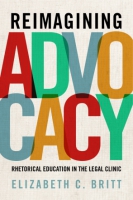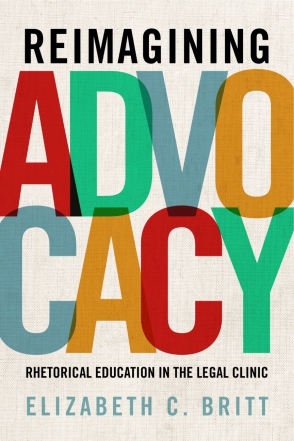Reimagining Advocacy
Rhetorical Education in the Legal Clinic
Elizabeth C. Britt
“There is so much to recommend about Britt’s excellent new book, but the aspect of this book that must not be lost is its emergence out of the author’s dedication to exploring the lived and material possibilities of rhetorical education in the twenty-first century. May we answer her call in law schools and rhetoric programs both.”
- Description
- Reviews
- Bio
- Table of Contents
- Sample Chapters
- Subjects
Focusing on clinical legal education at the Domestic Violence Institute at the Northeastern University School of Law, Britt takes a case-study approach to illuminate how challenging the context, aims, and forms of advocacy traditionally embraced in the U.S. legal system produces better support for victims of domestic violence. She analyzes a wide range of materials and practices, including the pedagogy of law school training programs, interviews with advocates, and narratives written by students in the emergency department, and looks closely at the forms of rhetorical education through which students assimilate advocacy practices. By examining how students learn to listen actively to clients and to recognize that clients have the right and ability to make decisions for themselves, Britt shows that rhetorical education can succeed in producing legal professionals with the inclination and capacity to engage others whose values and experiences diverge from their own.
By investigating the deep relationship between legal education and rhetorical education, Reimagining Advocacy calls for conversations and action that will improve advocacy for others, especially for victims of domestic violence seeking assistance from legal professionals.
“There is so much to recommend about Britt’s excellent new book, but the aspect of this book that must not be lost is its emergence out of the author’s dedication to exploring the lived and material possibilities of rhetorical education in the twenty-first century. May we answer her call in law schools and rhetoric programs both.”
“Overall, Elizabeth C. Britt’s Reimagining Advocacy is an exceptionally important text to contemporary rhetorical studies.”
“Elizabeth Britt’s book shows us that lawyers are rhetorical agents, a connection that has been diminished over time. Her study of ‘embodied advocacies’ can help lawyers think more broadly about what advocacy means.”
“A really powerful book. Reimaging Advocacy makes a strong and sustained case for intervening in calcified systems of gendered abuse. This text is well supported and provides a great deal of richness by weaving together interviews and vivid reflections about a system that is all too often broken for the victims most in need. Importantly, Britt doesn’t succumb to the cynicism that is so in vogue in academic scholarship; instead, she does the hard work of producing creative, productive criticism that offers alternative frameworks and practices for aiding victims of abuse.”
Elizabeth C. Britt is Associate Professor of English at Northeastern University. She is the author of Conceiving Normalcy: Rhetoric, Law, and the Double Binds of Infertility.
Contents
Preface
Acknowledgments
Introduction: Bodies, Perspectives, Advocacies
1. Attitudes toward Advocacy
2. At the Law School: Learning to Recognize the Expertise of Others
3. At the Hospital: Learning to Defer to Others
4. At the Courthouse: Learning to Support the Rhetorical Work of Others
Conclusion: Lessons
Appendix A: Research Methods
Appendix B: Interview Participants
Notes
Bibliography
Index
From the Introduction | Bodies, Perspectives, Advocacies
In August 2013, Jennifer Martel of Waltham, Massachusetts, was murdered by her boyfriend, Jared Remy. The son of a well-known broadcaster for the Boston Red Sox, Remy had a long criminal history of domestic violence, threats, and intimidation but had never served time. Two days before the murder, Remy had grabbed Martel by the neck and slammed her head into a bathroom mirror. He was arrested, and Martel obtained a twenty-four-hour emergency restraining order. At Remy’s arraignment the following morning, the assistant district attorney recommended—largely because Martel had not sought an extension of the restraining order—that Remy be released without bail. The judge agreed, with a special condition that Remy not abuse Martel. The next day, she was dead, stabbed to death by Remy at their home.
What might have made a difference for Jennifer Martel? According to an independent review, the assistant district attorney should have sought a hearing to determine if Remy was too dangerous to release. The review found that the assistant district attorney had enough information about the seriousness of the assault, Remy’s increasingly controlling behavior, and his criminal history to request that he be held without bail until trial or that additional conditions be attached to his release. The assistant district attorney had also misinterpreted Martel’s decision not to pursue an extended restraining order as an indicator that she was not at risk. No one from the district attorney’s office had talked with Martel about whether she felt safe or connected her with a domestic violence advocate or other resources.
We don’t know if Jared Remy would have obeyed an extended order. Research suggests that while restraining orders are largely effective in reducing violence, they are often defied and may precipitate violence. For this reason, many domestic violence advocates consider restraining orders an option that might not make sense in every circumstance. A domestic violence advocate might have asked Jennifer Martel, among other things, a series of questions designed to predict the likelihood that Remy would kill her. The advocate would have learned that Remy had grabbed her by the neck during the assault and that he was very controlling, both strong indicators of homicide risk. The advocate would have asked how Martel thought Remy would react to an extended restraining order and would have helped her strategize about legal and nonlegal options for staying safe. The advocate also could have helped others understand Martel’s choices and weigh them appropriately when making their own decisions. If the assistant district attorney and judge had more fully understood this bigger picture, they might have evaluated Remy for dangerousness rather than placing all responsibility with Martel.
In my description of how an advocate might have worked with Jennifer Martel, advocacy is a partnership in which the advocate listens to the client as an expert in her own life and provides access to resources and perspectives that can help the client make decisions. The assumptions underpinning this approach are a far cry from those informing a widely accepted narrative about the role of advocates. (For victims of domestic violence, advocates might include lawyers, staff of district attorneys’ offices, volunteers, and others.) According to this widely accepted narrative, an advocate possesses a privileged window into a client’s best interests, usually by virtue of professional expertise. Because of this expertise, the advocate’s role is to speak and make decisions for the client. In cases of domestic violence, this narrative is further complicated by stereotypes of victims as passive and weak, an attitude expressed in a local newspaper editorial a week after Martel’s murder that proclaimed victims of domestic violence “are often the ones least able to think, speak and act in their own best interests.”
Advocates operating according to this narrative are motivated by what I call a heroic attitude. Heroic advocates may not recognize that the client has a different but equally important expertise: an expertise in her own life. The heroic advocate may not recognize that the client, inhabiting a different body and having had different experiences, knows things that the advocate simply cannot know. Although perhaps driven by a sincere desire to help, the heroic advocate may undervalue the client’s knowledge and ability to act in her own best interest.
My portrait of the heroic advocate is admittedly simplistic. Yet elements of this attitude emerge in empirical studies of lawyers who represent disadvantaged clients. While lawyers for organizations or financially successful individuals tend to take direction from their clients, legal services lawyers—those who help the poor negotiate housing, public benefits, immigration, the criminal justice system, or other issues—tend to take charge. In one study, most legal services lawyers cited their clients’ lack of sophistication as a primary reason for assuming a dominant role in decision-making. Recognizing that such lawyer-client roles can exacerbate the problems they are trying to solve, legal scholars specializing in poverty law have developed new models of advocacy for those disadvantaged by the legal system. Legal scholars specializing in domestic violence have had similar insights, recognizing that advocacy strategies too often rely on dominant conceptions of their clients as helpless and weak—and therefore as incapable of making competent decisions.
This book analyzes an effort to teach one of these models to future lawyers. I study two clinical legal programs organized by the Domestic Violence Institute (DVI) at Northeastern University School of Law. In legal clinics, students work with clients, often from marginalized populations, on actual problems. In one of the DVI programs, law students learned to listen to women in the emergency department of a major urban hospital talk about domestic violence. In the other, students learned to help people file for restraining orders in municipal courts. The advocacy model taught in both programs, called client empowerment, positions the client rather than the advocate as the primary decision-maker. In the client-empowerment model, the advocate’s role is to help the client see avail- able options—legal and nonlegal—and support her in carrying out her own decisions.
As a rhetorician, I am interested in these programs as rhetorical education in advocacy for another. The book analyzes a wide range of rhetorical practices, including speaking, writing, reading, listening, using silence, supporting the rhe- torical practices of others, and moving one’s body. By calling these practices rhetorical, I mean to emphasize that they present a point of view, help constitute identities, and influence thought and action. Central to my analysis is that rhetoric is what Jacqueline Jones Royster calls a “whole-body experience,” or action that simultaneously involves thinking, sensing, and feeling.
I use the term rhetorical education to refer to the teaching and learning of rhetorical practices as well as the necessarily embodied development of attitudes toward—and capacities for—rhetorical action. Ideally, rhetorical education has a civic function, developing what William Keith and Roxanne Mountford describe as “citizen participants, not simply future employees or more literate students.” Through rhetorical education, students ideally develop the capacity to form judgments about issues of public concern and influence others. Because rhetorical education focuses on public life, it has the potential to act with other forms of education to promote social change, even if it cannot solve all social problems. But since rhetorical education is always about power relations—about who can participate and in what forms—it can simultaneously promote the dominant culture while erasing the voices of those from subordinated groups.
I argue in this book that the law students in the DVI programs learned an embodied approach to advocacy that resulted from an expanded notion of expertise based on lived experience. Through rhetorical listening, the students came to understand that because they and their clients inhabited different bodies, they necessarily had different world views and goals and would experience the consequences of any act of advocacy differently. They developed what I call an attitude of deference, which entailed recognizing their clients as experts in their own lives and therefore as having the right and ability to make decisions for themselves. But rather than leaving clients completely to their own devices, students learned practices that supported their clients’ rhetorical work, often by drawing on their own knowledge of the law or patterns of abusers. Although these practices did not usually involve speaking for their clients, they constituted advocacy in the sense that they supported their clients’ interests. Moreover, advocacy in these settings wasn’t performed by any one person occupying a particular institutional role but was distributed across a number of actors, including the client herself. For this reason, I often refer to advocacies in the plural. Students learned these attitudes and practices through a range of embodied pedagogies.
This book offers new perspectives to a wide range of readers. To readers in any field, the book provides insight into the value of listening to those abused by intimate partners. Given that a third of women in the US will experience domestic violence in their lifetimes, everyone knows someone it has touched. But many stories remain untold or unheard. Over the years that I have worked on this project, family members, friends, and colleagues have told me about their own experiences, some decades old and some recent. Their stories have shown me the complexity of domestic violence and the challenges victims continue to face, even in twenty-first-century America.
The DVI, as depicted in this book, should inspire those who serve victims of domestic violence. Advocates working on behalf of other populations may also recognize the attitudes explored here and consider ways to improve their own practices or complicate the analyses I have offered. Educators in all disciplines may find ways to adopt or adapt the pedagogies described.
This book should spark conversations to connect contemporary American legal education with rhetorical education. Although they were born together in the ancient law courts of Greece and Rome, law and rhetoric are largely separate in the modern research university. For rhetoricians, the book introduces how legal scholars, law teachers, and lawyers theorize, practice, and teach advocacy, a central but largely taken-for-granted concept in our own field. Rhetoricians have much to learn from clinical legal educators in particular, who have developed especially rich ways to account for advocating with others, the central concern of this book. For legal scholars and educators, the book shows how rhetorical theory offers a helpful counterpoint to the decontextualizing tendencies of the predominant pedagogy in American law schools. Reconnecting with rhetoric has the potential to help law schools produce not just competent interpreters of legal texts but citizen participants with practical wisdom.
Legal Education as Rhetorical Education
In ancient Greece and Rome, rhetorical education emphasized the production of rhetors who could perform effectively in both public and private arenas, including the law courts. Specifically, classical pedagogies focused on developing in students the capacity (in Greek, dunamis) to deliberate ethically and speak persuasively. Today, however, contemporary rhetorical education and legal education are divided, each devoted primarily to the production of knowledge in their respective disciplines.
Contemporary legal education in the US focuses students’ attention on the production of knowledge through a standard method of instruction known as the case method. In the case method, students read appellate judicial opinions, which form the body of American common law. Students learn to see cases as reservoirs of legal doctrine that they can use to predict how courts might interpret similar legal disputes (actual or potential) involving their clients. Because these doctrines are often implied rather than explicit, law students learn to extrapolate them, a process that has come to be known as “thinking like a lawyer.”
The case method was introduced in the late nineteenth century at Harvard Law School. Until that time, students learned law either through apprentice- ships with experienced attorneys or through the lecture method prevalent at law schools. Even at Harvard, the lecture method was not seen as particularly intellectual, consisting primarily of faculty reading from legal treatises such as Blackstone’s commentaries and testing students’ abilities to memorize. The case method was part of broader reforms across Harvard University, inspired by the German research university, aimed at making higher education more intellectual by training students to become producers of scientific knowledge. Although today seen as far removed from clinical legal education (CLE), the case method was understood at the time as analogous to clinical medical education, in which students learned about medicine by working with patients to understand how to diagnose and treat illness. Unlike medical students, however, law students were to focus not on human beings but on texts; in the words of legal historian Anthony Chase, “law books were to the law student what the bodies of the sick and wounded were to the medical student.”
The case method represented a dramatic epistemological shift, characteristic of the new research university, from“shaping the self ” to producing knowledge. The method’s emphasis on producing knowledge, which remains central today, has been both praised and critiqued. In a 2007 empirical study of sixteen law schools in the US and Canada, researchers sponsored by the Carnegie Foundation argue that the method rapidly inculcates in students the ability to read, think, and argue like members of the legal profession. And in a separate study of eight law schools published the same year (2007), anthropologist Elizabeth Mertz calls the method “an enormously creative system for processing human conflict.” However, the case method is criticized by both Mertz and the Carnegie researchers for distancing students from social and moral concerns. By viewing human action through the lens of legal rules, the case method ignores the complex and often painful contexts that form the bases of legal disputes.
According to the Carnegie researchers, CLE is a particularly promising cor- rective to the decontextualization of the case method. In a legal clinic, students put their knowledge into practice, developing professional judgment through the “experience of lived responsibility.” Working with actual clients, students can see that human conflicts are not just legal problems. By noticing the real- world effects of their own judgments, students learn that legal action entails ethical responsibility.
(Excerpt ends here)
Also of Interest
Mailing List
Subscribe to our mailing list and be notified about new titles, journals and catalogs.






